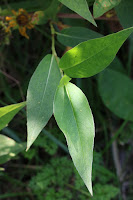 Not long ago, I would have strolled past this botanical unicorn without a second thought. I probably wouldn't have even noticed it, hunkered down in the mowed strips alongside the Greenway, pearly white leaves gleaming in the sun.
Not long ago, I would have strolled past this botanical unicorn without a second thought. I probably wouldn't have even noticed it, hunkered down in the mowed strips alongside the Greenway, pearly white leaves gleaming in the sun.But now--now I know to stop and take a closer look. It was an albino--I tentatively identified it as a smartweed (perhaps Swamp Smartweed, Persicaria amphibia), with tapering leaves and fine short hairs covering the leaves and stems. A couple feet away was were some standard-issue smartweeds, looking for all the world like my ghostly mutant only bearing the expected green tint.
Given that the green coloration in plants is due to chlorophyll, the pigment that makes photosynthesis possible, how can a pure-white plant like this one survive? Normally an albino seedling might grow briefly until its food stores from the seed are depleted, then starve when it is unable to feed itself. Some albinos, such as the famed albino redwoods, can survive for years by parasitizing the roots of nearby normal redwoods. This allows the albino to tap into the root system of other trees that photosynthesize normally, presumably without deleterious effect on its hosts.
 I suspect my albino smartweed has a similar understanding with its neighbors: perhaps it is able to sustain itself by tapping into the roots of the nearby plants, or it is itself a mutated shoot from underground rhizomes of a nearby parent. Though it seems to be surviving well enough right now, save for some singed leaf-tips, it likely will not be long for this world. The combination of mowing and bright sunlight will stress its already fragile leaves, and its inability to photosynthesize is something of a deal-breaker in the botanical world.
I suspect my albino smartweed has a similar understanding with its neighbors: perhaps it is able to sustain itself by tapping into the roots of the nearby plants, or it is itself a mutated shoot from underground rhizomes of a nearby parent. Though it seems to be surviving well enough right now, save for some singed leaf-tips, it likely will not be long for this world. The combination of mowing and bright sunlight will stress its already fragile leaves, and its inability to photosynthesize is something of a deal-breaker in the botanical world. |
| Possible host for the nearby albino |
So my ephemeral, unpigmented friend will be all the more lovely for its brief stay on the Greenway.
No comments:
Post a Comment